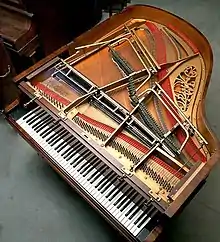
The luthéal is a kind of hybrid piano which extended the "register" possibilities of a piano by producing cimbalom-like sounds in some registers, exploiting harmonics of the strings when pulling other register-stops, and also some registers making other objects, which were lowered just above the strings, resound. The instrument became obsolete partly because most of its mechanics were too sensitive, needing constant adjustment. The only pieces in the general repertoire to feature the luthéal are L'enfant et les sortilèges (1920–25) and Tzigane (1924), by Maurice Ravel.
History
The attachment was created by the Belgian organ builder Georges Cloetens, who first patented it on 28 January 1919 and named it the "Jeu de harpe tirée".[1] Maurice Ravel used it in Tzigane for violin and piano, and in the opera L'Enfant et les sortilèges.[1]
It generates a range of colours by adding two treble and two bass stops to a normal grand piano. These enable it to produce, in addition to the normal piano sound, additional timbres resembling cimbalom, harpsichord, and harp (or lute).[2]
The luthéal was, in Ravel's day, a comparatively new piano attachment that had several registrations that could be engaged by pulling stops above the keyboard. One of these registrations had a cimbalom-like sound, which fitted well with the gypsy-esque idea of Tzigane. The printed version of the original scores of that piece and L'Enfant et les sortilèges contained instructions for these register-changes during execution. The Luthéal, however, did not survive: by the end of the 20th century the first print of the luthéal version of the accompaniment was still at the publishers, but the chamber version of the piece had long been performed in Ravel's alternative specification for the ordinary piano.
A surviving original luthéal was discovered in storage in the museum of the Brussels Conservatory and has been restored[1] by Evert Snel from The Netherlands to playing condition.This instrument was sampled in 2011 so that its sounds are also available for music productions.[3] Evert Snel made a copy of the lutheal in a Fazioli grand piano. A new instrument was commissioned in 1987 by the French government on the occasion of the fiftieth anniversary of Ravel's death, and is now in the Musée de la Musique, Paris.[1]
Revivals
Violinist Daniel Hope recorded in 2004[4] a performance of Ravel's Tzigane that features a reconstructed luthéal, which Hope describes in a National Public Radio interview as "a cross between a typewriter and an organ that attaches to the strings of a piano" and produces "an amazing sound world."[5] Violinist Chantal Juillet also made a recording with Pascal Rogé on piano luthéal, found on Ravel: The Complete Editions on Decca Records.[6] Violinist Sarah Nemtanu also recorded Ravel's Tzigane with Romain Descharmes on piano luthéal on Naïve Records., as did violinist Lina Tur Bonet with Pierre Goy on Challenge Records.[7]
See also
References
- 1 2 3 4 Cotte, Roger J. V. 2001. "Luthéal [Piano-Luthéal]". The New Grove Dictionary of Music and Musicians, second edition, edited by Stanley Sadie and John Tyrrell. London: Macmillan Publishers.
- ↑ Hugh Davies, "Instrumental Modifications and Extended Performance Techniques", The New Grove Dictionary of Music and Musicians, second edition, edited by Stanley Sadie and John Tyrrell (London: Macmillan Publishers).
- ↑ Review sound library Luthéal (German-language)
- ↑ 2004 album East Meets West: East Meets West
- ↑ 2008 interview: "The Glamorous Life Of Daniel Hope", NPR.org.
- ↑ "Ravel – The Complete Edition: Decca: 4783725", PrestoClassical.co.uk.
- ↑ 2022 album À Moune:
Further reading
- Anon. 1973. "Séances de la Société: séance du jeudi 14 juin 1972". Revue de Musicologie 59:317. [Report on Roger Cotte, Un instrument de musique peu connu, le luthéal, utilisé par Maurice Ravel.]
- Cotte, Roger J. V. 1976. "Le luthéal". Hi-fi stéréo: 221–24
- Davies, Hugh. 1988. "Maurice Ravel and the Luthéal". Experimental Musical Instruments 4, no. 2 (August): 11–14.
- DeVoto, Mark. 2000. "Harmony in the Chamber Music". In The Cambridge Companion to Ravel, edited by Deborah Mawer, 97–117. Cambridge Companions to Music. Cambridge: Cambridge University Press. ISBN 0-521-64026-1 (cloth); ISBN 0-521-64856-4 (pbk).
- Marcuse, Sibyl. 1975. Musical Instruments: A Comprehensive Dictionary. The Norton Library. New York: W. W. Norton & Company, Inc. ISBN 0-393-00758-8.
External links
- "Pleyel Grand Piano with 'Luthéal' Mechanism". Musical Instruments Museum website (Accessed 17 June 2010).